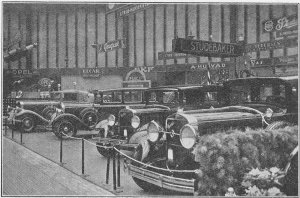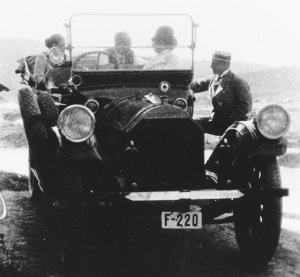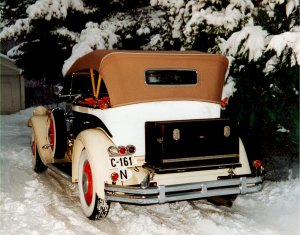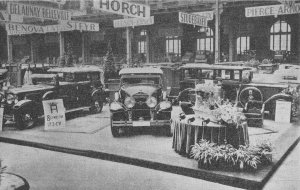- Home
- About Us
- Join/Renew
- Member Benefits
- Member Pages
- Log In
- Help
- Museum Store
I found this photo in a norwegian motor magazine from 1930. It is from an Automobile Exibition in Copenhagen. The print of the photos were not of the best quality in those days. Anyway you will observe the Pierce-Arrow on the left side at the Studebaker Stand.

Hello Oivind,
I’m curious, the photo shows what appear to be left hand drive vehicles, would that have been the norm for cars in Copenhagen or would the majority of cars be right hand drive?
In Scandinavia both Danmark and Norway did always have the same system as you have in US – driving on the right side of the road. In Sweden they drove the cars on the left side as they still do in England. In 1967 Sweden switched the side. In those days there was a joke in Norway before the swede switched over: They tested out the right hand system first by trying buses and trucks drive on the right side…
Many manufactorers of cars produced cars with right hand steering in the beginning, as also Pierce-Arrow did. The customer in fact did not have any choice. See the enclosed photo of an old Pierce in Norway.

Oivind,
Does that 1914 C-2 in Norway still exist? About what year was the photo taken?
Oivind,
Thanks for the fascinating pictures! How has your winter weather
gone?
The owner of this 1914 Pierce-Arrow was an active participant of motorsports. He begun with motorcycles. He owned both Henderson and Indian. He acquired the Pierce in 1919 – after the WW-1. So I believe this was a used car – from France?
In 1921 the owner, Herman Oppen, participated in the first road rally in Norway after the war. It had a distance of 580 kilometer (362 miles) and they were driving over the night. In addition to the road rally he also was active in hill climbing competition with the car. The photo is from the start of the rally in 1921.

In February 1925 he was a competitor in an ice race on a lake some 30 miles outside Oslo. On some places the ice was not strong enough and the heavy Pierce went through the ice and was lying on the bottom , some 10 feet deep. Mr. Oppen was saved and not hurt at all – only wet…
Some days later the car was saved (photo) by building a wood crane over the hole in the ice. The Pierce could then be winched up. In the official registration papers of the Pierce there was a note that the car later was sold in Oslo. I have never found out who was the buyer.

Anthony,
We have had a nice cold winther so far without to much snow, round 10-12 inch. deep. The last 14 days we have had much sunshine. Perfect for skiing and driving. The problem is that they are using to much salt on the roads.

Oivind,
Thank You for your reply.Your posts are very informative and the
lake recovery is unbelievable!I wonder what gear the diver used to
survive the temperatures? How the lines were attached to avoid damage
to the car? How the crane was fashioned on ice that wouldn’t support
the weight of the car?
The cars parked in front of the Pierce in the top picture are a
1919 Buick H-45(6 cyl.,124 inch wheelbase,2,950 lbs.,44,589
domestically built),and a 1918 Cadillac Mod. 57(V8,125 inch wheelbase,
4035 lbs.,$2,950,combined 1918 &1919 production=45,146,314 cu.in.).
The 38-C-2 might have even been originally sold in Russia. There was an agency in Petrograd during the war. Some 200 38-C-3 touring cars were sold to the Russian government, along with hundreds of trucks.
By the way, the auto show photo looks more like 1929 Studebakers instead of 1930s.
Roger,
Thank you for the information of the cars sold to Russia. I will try to find out more in this matter.
I will not go into a discussion of the year of the Studebakers. I do not have enough knowledge of that brand. In fact the photo was one of more from the exhibition in Copenhagen in may 1930. Could it be som left overs from 1929?
I started this discussion with the photo of an exhibition. Here is another one – from Paris in 1929. Sorry, you can not see any Pierce-Arrows, only the sign.

Darn those Horch people! Always copying Studebaker/Cadillac design
cues.How about being more Teutonic in your approach.They even ripped
the straight eight off of Duesenberg/Packard/Hupmobile.The shame of it
all.Thanks for sharing the fine pictures with us.
P.S. I believe that Hupmobile was the world’s largest producer of
straght eights in ’25-’26.It’s Model E1 cost $1,975 and 118 1/4
inch wheelbase, was reduced to $1,795 in ’26 as the E2.
